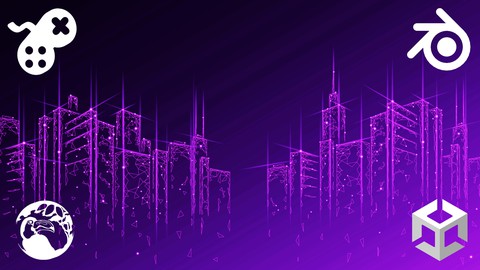Overview of Learn to Program & Model Procedural Cities in Unity/Blender Course on Udemy
Dive into the fascinating world of procedural generation with the “Learn to Program & Model Procedural Cities in Unity/Blender” course on Udemy. This comprehensive course guides you through the art and science of creating virtual cities algorithmically, perfect for game developers and 3D artists alike. Spanning 16 hours of on-demand video content and enriched with 32 downloadable resources, this course is led by expert instructors Penny de Byl and Michael Bridges, who bring decades of industry and academic experience to the table. Whether you’re aiming to craft sprawling cityscapes for games or virtual environments, this course equips you with the tools to succeed.
Enroll today with coupon NO_FOOL_IN_APRIL (valid until April 30, 2025—check the offer box below for the discount link!) and start building your procedural city toolkit now!
What to Expect from the Learn to Program & Model Procedural Cities in Unity/Blender Course
This 16-hour course offers a holistic learning experience, blending technical programming with artistic design. Penny de Byl and Michael Bridges employ a hands-on teaching style, making complex concepts accessible through step-by-step workshops. Designed for intermediate programmers and 3D artists with some knowledge of Unity and/or Blender, the course caters to those eager to explore procedural generation. Hosted on Udemy, it provides lifetime access and the flexibility to learn at your own pace—perfect for busy professionals or hobbyists looking to level up their skills.
Expect practical exercises, real-world examples, and a modular approach that transitions from manual design to fully procedural techniques, ensuring you master both the “how” and “why” behind city creation.
What You Will Learn in Learn to Program & Model Procedural Cities in Unity/Blender
Here’s what you’ll gain from this course:
- Understand the nature of 3D space and how to create grids for snapping 3D models together seamlessly.
- Identify and implement procedural algorithms to generate virtual city maps dynamically.
- Apply fractal and dynamic methods to craft buildings and cities algorithmically.
- Build a bespoke, procedurally generated city map featuring districts, population densities, and vegetation.
- Master Blender’s Modifier Stack and Geometry Node system for automated asset placement.
- Utilize Unity to manipulate road models and populate cities with residential, commercial, and industrial zones using algorithms like Voronoi Diagrams and Perlin Noise.
Why Choose This Learn to Program & Model Procedural Cities in Unity/Blender Course on Udemy
This course stands out due to the expertise of instructors Penny de Byl, a seasoned academic and game developer, and Michael Bridges, a skilled 3D artist. Their combined knowledge ensures a balanced focus on both programming logic and artistic design—an edge for anyone in the game development field. The content is continuously updated to reflect the latest tools (Unity 2020.3 and Blender 3.0), offering practical, real-world value. With 16 hours of video and 32 downloadable resources, it’s a comprehensive package that justifies every minute spent.
Use NO_FOOL_IN_APRIL to snag it at a discount (see offer box) and unlock a skill set that sets you apart in the job market or indie game scene!
Recommended Courses with Procedural Generation Focus
Looking to expand your skills? Check out these related courses:
Complete C# Unity Game Developer 3D (Updated To Unity 6) Best seller
Mastering Unity Muse New
- Procedural Terrain Generation with Unity – Master terrain creation with C# and Unity’s powerful tools.
- Unity Shader Graph: Create Procedural Shaders & Dynamic FX – Elevate your visuals with custom shaders.
- Master Procedural Maze Generation – Unity 6 Compatible – Build dynamic dungeons and mazes with Unity and Blender.
Our Review of Learn to Program & Model Procedural Cities in Unity/Blender Course
As the admin of this website, I found this course to be a standout in the realm of procedural generation education. The structure is well-paced, split into two parts—Part A with Michael Bridges focusing on Blender modeling, and Part B with Penny de Byl diving into Unity programming. Both instructors shine with clear explanations and a passion for teaching that keeps you engaged. The practical workshops are a highlight, offering tangible skills you can apply immediately to game projects.
Pros:
- Comprehensive coverage of both Unity and Blender, bridging art and code seamlessly.
- Expert instructors with a knack for breaking down complex topics.
- Hands-on projects that build a professional-grade portfolio piece.
Cons:
- Requires prior knowledge of Unity/Blender, which may deter absolute beginners.
- The 16-hour duration might feel lengthy for those seeking a quick intro.
With NO_FOOL_IN_APRIL, it’s a steal for the value it delivers!
Rating the Learn to Program & Model Procedural Cities in Unity/Blender Course
Overall Rating: 9.2/10
- Content: 9/10 – Packed with actionable techniques and algorithms, though beginners might need a primer first.
- Delivery: 9.5/10 – Penny and Michael’s teaching is engaging and thorough, with real-world insights.
- Value: 9/10 – Affordable with NO_FOOL_IN_APRIL, offering immense practical worth for the price.
Don’t miss out—grab this course today and transform your game development skills with procedural mastery!











